
Return of the Jedi is a 1983 American epic space opera film that is the sequel to Star Wars (1977) and The Empire Strikes Back (1980). It is the third installment in the original Star Wars trilogy and the sixth chronological film in the "Skywalker Saga". It is directed by Richard Marquand based on a screenplay by Lawrence Kasdan and George Lucas from a story by Lucas, who was also the executive producer. The film follows the ongoing struggle between the malevolent Galactic Empire and the freedom fighters of the Rebel Alliance. As the Rebels attempt to destroy the Empire's second Death Star, Luke Skywalker hopes to bring his father, Darth Vader, back from the dark side of the Force. The film stars Mark Hamill, Harrison Ford, Carrie Fisher, Billy Dee Williams, Anthony Daniels, David Prowse, Kenny Baker, Peter Mayhew and Frank Oz.
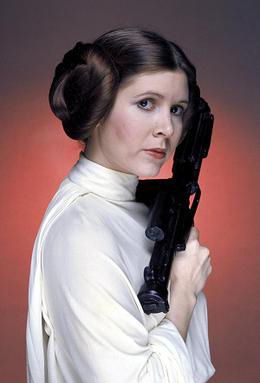
Princess Leia Organa is a fictional character and one of the main characters in the Star Wars franchise, portrayed by Carrie Fisher. Introduced in the original Star Wars film in 1977, Leia is princess of the planet Alderaan, a member of the Imperial Senate and an agent of the Rebel Alliance. She thwarts the sinister Sith Lord Darth Vader and helps bring about the destruction of the Empire's cataclysmic superweapon, the Death Star. In The Empire Strikes Back (1980), Leia commands a Rebel base and evades Vader as she falls in love with the smuggler Han Solo. In Return of the Jedi (1983), Leia helps in the operation to rescue Han from the crime lord Jabba the Hutt and is revealed to be Vader's daughter and the twin sister of Luke Skywalker.
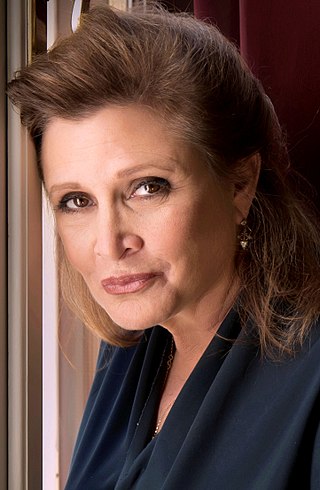
Carrie Frances Fisher was an American actress and writer. She played Princess Leia in the original Star Wars films (1977–1983) and reprised the role in Star Wars: The Force Awakens (2015), Star Wars: The Last Jedi (2017)—a posthumous release that was dedicated to her—and Star Wars: The Rise of Skywalker (2019), through the use of unreleased footage from The Force Awakens.

Bib Fortuna is a fictional character in the Star Wars franchise. The Twi'lek majordomo and chief aide of the crime lord Jabba the Hutt, Bib is Jabba's closest associate, succeeding him as daimyo after his death before ultimately being killed himself by Boba Fett. Fortuna first appeared in Return of the Jedi (1983), the final entry in the original Star Wars trilogy. He also appeared briefly in the prequel trilogy film The Phantom Menace (1999) and in the second season of Disney+ series The Mandalorian (2020) and The Bad Batch (2021). The character has also appeared in other Star Wars media, including novels, comic books, video games, and radio dramas.

The Sarlacc is a fictional creature in George Lucas's sci-fi action saga Star Wars. It first appeared in the film Return of the Jedi (1983) as a multi-tentacled alien beast whose immense, gaping maw is lined with several rows of sharp teeth, inhabiting the Great Pit of Carkoon, a hollow in the sand of the desert planet Tatooine. After the bounty hunter Boba Fett escapes from its maw in "Chapter 1: Stranger in a Strange Land" of The Book of Boba Fett (2022) and eventually returns to retrieve his armor, the Sarlacc is killed by his partner Fennec Shand in "Chapter 4: The Gathering Storm".
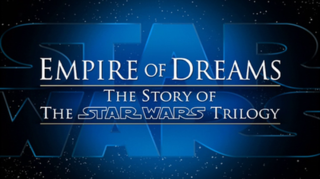
Empire of Dreams: The Story of the Star Wars Trilogy is a 2004 documentary film directed by Kevin Burns and narrated by Robert Clotworthy. It documents the making of the original Star Wars trilogy: Star Wars (1977), The Empire Strikes Back (1980), and Return of the Jedi (1983), and their impact on popular culture.

Nien Nunb is a fictional character in the Star Wars franchise. Introduced in the 1983 film Return of the Jedi, he was brought to life both as a puppet and a costumed actor during the film. Nunb was puppeteered by Mike Quinn and was portrayed by Richard Bonehill in wide shots. The character was voiced by Kipsang Rotich, a Kenyan student who spoke in his native Kalenjin, as well as in Kikuyu. Quinn and Rotich both returned for the role in the sequel trilogy, namely Star Wars: The Force Awakens (2015), Star Wars: The Last Jedi (2017), and Star Wars: The Rise of Skywalker (2019).
Star Wars Infinities is a graphic novel trilogy published by Dark Horse Comics from 2002 to 2004. It tells a non-canon alternate version of each film in the original Star Wars trilogy in which a point of divergence occurs and changes the outcome of the story. Each individual Infinities story is unrelated to the others and is set within the timeline of their original film.
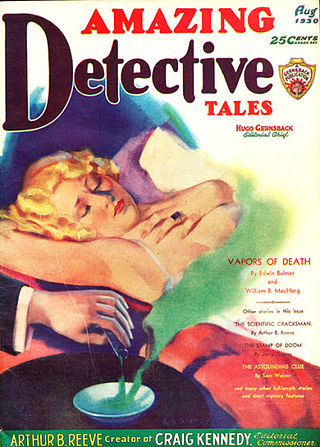
Earle K. Bergey was an American artist and illustrator who painted cover art for thousands of pulp fiction magazines and paperback books. One of the most prolific pulp fiction artists of the 20th century, Bergey is recognized for creating, at the height of his career in 1948, the iconic cover of Anita Loos's Gentlemen Prefer Blondes (1925) for Popular Library.
The Star Wars sequel trilogy is the third trilogy of the main Star Wars franchise, an American space opera created by George Lucas. It is produced by Lucasfilm Ltd. and distributed by Walt Disney Studios Motion Pictures. The trilogy consists of episodes VII through IX, chronologically following the prequel trilogy and the original trilogy, serving as the final act of the "Skywalker Saga". Lucas had planned a sequel trilogy as early as 1976, but canceled it by 1981. He produced only the first six episodes, and for a time described these as comprising the complete story. The sequel trilogy concept was revived when the Walt Disney Company entered negotiations to acquire Lucasfilm in 2011. Lucas produced new story treatments, but these were largely discarded. Both the acquisition and plans to produce the trilogy were announced in late 2012.
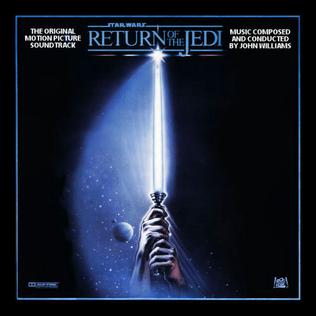
Star Wars: Return of the Jedi is the film score to the 1983 film Return of the Jedi, composed and conducted by John Williams and performed by the London Symphony Orchestra. The score was recorded at Abbey Road Studios in London between January and February 1983. Again, John Williams served as producer. Herbert W. Spencer, Thomas Newman and Gordon Langford served as orchestrators. Engineer Eric Tomlinson, music editor Kenneth Wannberg, and record supervisor Lionel Newman again reprised their respective duties. The score earned another Academy Award nomination for Williams. Return of the Jedi, which is the original trilogy's shortest score, was only released on a single-LP instead of a double-set like the Star Wars and The Empire Strikes Back soundtracks before it.

The modern bikini first appeared in 1946, and since then it has become a part of popular culture. It is one of the most widely worn women's swimsuits, used for swimming and in a variety of other contexts. Today, bikinis appear in competitions, films, magazines, music, literature, and video games. Despite the availability of more revealing glamour wear, bikini modeling remains popular and can still create controversy. Portrayals of the bikini in popular culture led, to a large extent, to its acceptance by Western society at large. In 1960, Brian Hyland's pop song "Itsy Bitsy Teenie Weenie Yellow Polkadot Bikini" inspired a bikini-buying spree. The white bikini worn by Ursula Andress as Honey Ryder in the 1962 James Bond film Dr. No has been cited as one of the most famous bikinis of all time. By 1963, the movie Beach Party, starring Annette Funicello and Frankie Avalon, led a wave of films that made the bikini a pop-culture symbol. Playboy first featured a bikini on its cover in 1962. The Sports Illustrated Swimsuit Issue debuted two years later. This increasing popularity was reinforced by its appearance in such contemporary films as How to Stuff a Wild Bikini featuring Annette Funicello and One Million Years B.C. (1966) featuring Raquel Welch. Raquel Welch's fur bikini in One Million Years B.C. became a famous moment in cinema history. Hollywood stars such as Marilyn Monroe, Jayne Mansfield, Gina Lollobrigida and Jane Russell further helped the growing popularity of bikinis. Pin up posters of Monroe and Mansfield, as well as Hayworth, Bardot and Raquel Welch distributed around the world contributed significantly to the popularity of the bikini.

Jabba Desilijic Tiure, more commonly known as Jabba the Hutt, is a fictional character and major antagonist in the Star Wars franchise. Created by George Lucas, Jabba is voiced by Larry Ward with several puppeteers inside a one-ton puppet portraying him in Return of the Jedi. He was originally supposed to first appear in Star Wars (1977) as a stop motion character with Declan Mulholland as his stand-in. Jabba was later added into the film as a CGI character when it was re-released in Special Edition in 1997. He also appears in the prequel movie The Phantom Menace. The character is a large slug-like creature based on annelid worms, but he was originally designed as an apelike figure.

Han Solo is a fictional character in the Star Wars franchise created by George Lucas. The character first appeared in the 1977 film Star Wars portrayed by Harrison Ford, who reprised his role in The Holiday Special (1978), The Empire Strikes Back (1980), and Return of the Jedi (1983). Ford returned to the role for The Force Awakens (2015), as well as a brief cameo in The Rise of Skywalker (2019). In the spin-off film Solo (2018), a younger version of the character is portrayed by Alden Ehrenreich, while in the animated series Forces of Destiny (2017–2018), the character is voiced by Kiff VandenHeuvel and A.J. LoCascio.

Fan service, fanservice or service cut is material in a work of fiction or in a fictional series that is intentionally added to please the audience, often sexual in nature, such as nudity. The term originated in Japanese in the anime and manga fandom, but has been used in other languages and media. It is about "servicing" the fan—giving the fans "exactly what they want". Fan service can also refer to other stories that contain visual elements.
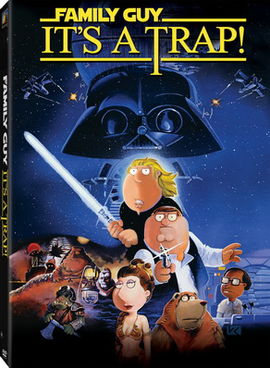
"It's a Trap!" is a direct-to-video special of the animated series Family Guy, which later served as the two-part season finale of the show's ninth season, and is the third and final part of the series' Star Wars parody trilogy Laugh It Up, Fuzzball. It is named after the phrase uttered by Admiral Ackbar in the Star Wars film Return of the Jedi. The home video was first released on December 21, 2010, and the episode later aired on Fox in the United States on May 22, 2011.

Star Wars: In Concert, previously referred to as Star Wars: A Musical Journey, is a series of concerts featuring a symphony orchestra and choir, along with footage from the Star Wars saga films displayed on a large LED screen at three stories tall. The screen is set to live performances of the Star Wars score composed by John Williams. The first performance took place in The O2 Arena in London, England and was attended by approximately 20,000 fans. The first North American tour started in Anaheim, California on October 1, 2009, and the second and most recent North American tour ended in London, Ontario on April 14, 2015. The concert series was scheduled to return sometime in 2016, but has since been delayed.

Classic Creatures: Return of the Jedi is a television documentary, first broadcast on CBS in 1983. It is a look behind-the-scenes of the creation of the various alien creatures from the third Star Wars film, Return of the Jedi, which was released that year. The documentary was presented by Star Wars actors Carrie Fisher and Billy Dee Williams, and directed by Robert Guenette who had directed the previous television specials The Making of Star Wars (1977) and SP FX: The Empire Strikes Back (1980).

Star Wars: The Rise of Skywalker is a 2019 American epic space opera film produced, co-written, and directed by J. J. Abrams. Produced by Lucasfilm and Abrams' production company Bad Robot, and distributed by Walt Disney Studios Motion Pictures, it is the third installment of the Star Wars sequel trilogy, following The Force Awakens (2015) and The Last Jedi (2017), and the final episode of the nine-part "Skywalker saga". Its ensemble cast includes Carrie Fisher, Mark Hamill, Harrison Ford, Adam Driver, Daisy Ridley, John Boyega, Oscar Isaac, Anthony Daniels, Naomi Ackie, Domhnall Gleeson, Richard E. Grant, Lupita Nyong'o, Keri Russell, Joonas Suotamo, Kelly Marie Tran, with Ian McDiarmid and Billy Dee Williams. Set one year after The Last Jedi, The Rise of Skywalker follows Rey, Finn, and Poe Dameron as they lead the Resistance's final stand against Supreme Leader Kylo Ren and the First Order, who are aided by the Sith Lord, Emperor Palpatine.
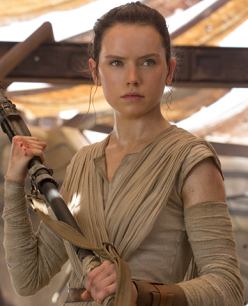
Rey is a character in the Star Wars franchise and the main protagonist of the sequel film trilogy. She was created by Lawrence Kasdan, J. J. Abrams, and Michael Arndt for The Force Awakens (2015), the first installment of the trilogy, and is primarily portrayed by Daisy Ridley. She also appears in the film's sequels, The Last Jedi (2017) and The Rise of Skywalker (2019), and related Star Wars media.





















